cruise control MITSUBISHI ECLIPSE 1991 Owner's Manual
[x] Cancel search | Manufacturer: MITSUBISHI, Model Year: 1991, Model line: ECLIPSE, Model: MITSUBISHI ECLIPSE 1991Pages: 1216, PDF Size: 67.42 MB
Page 571 of 1216
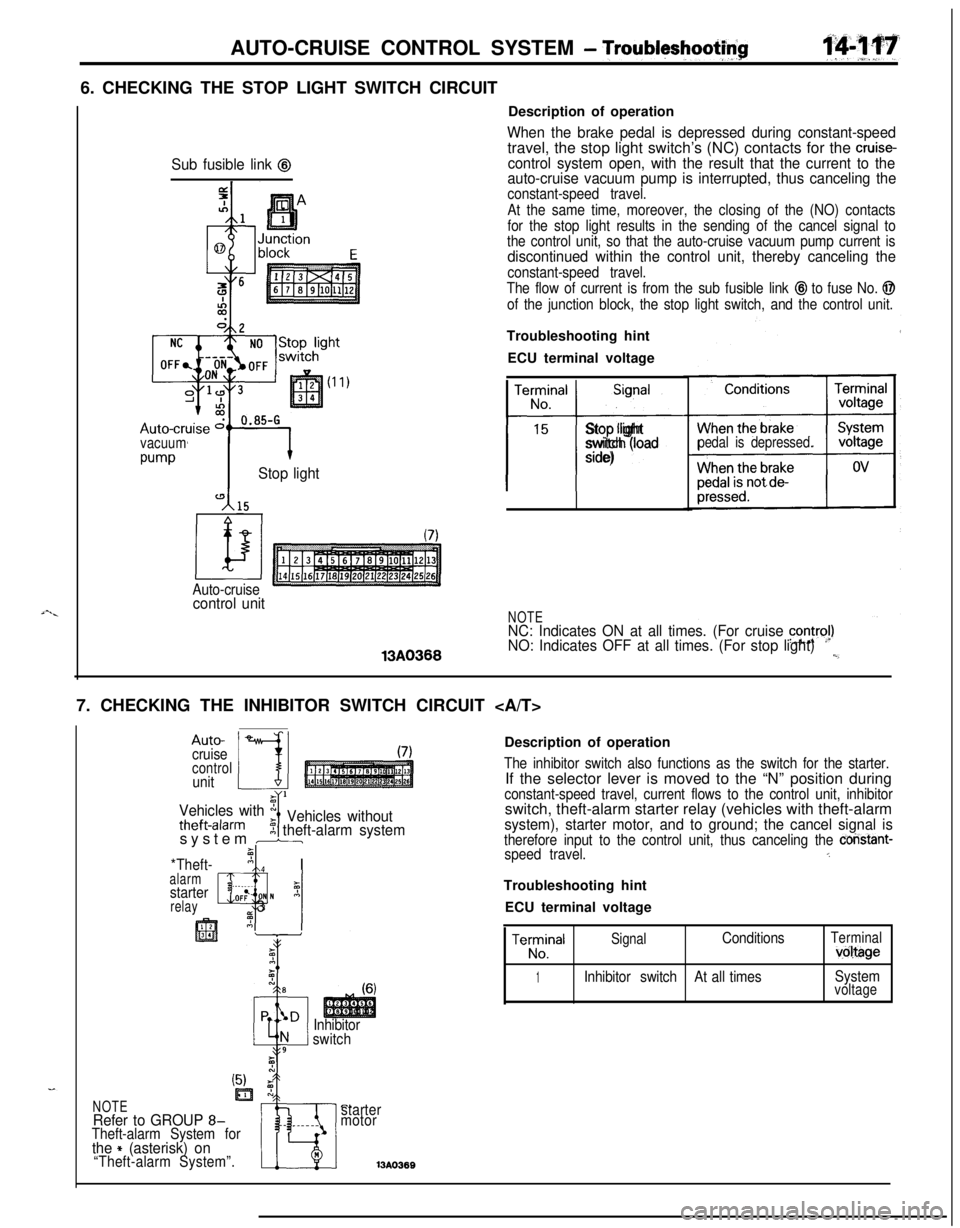
i-._AUTO-CRUISE CONTROL SYSTEM
- Troubltyshootf$6. CHECKING THE STOP LIGHT SWITCH CIRCUIT
Sub fusible link @
vacuum
w-vStop light
Auto-cruisecontrol unit13A0366Description of operation
When the brake pedal is depressed during constant-speedtravel, the stop light switch’s (NC) contacts for the cruise-control system open, with the result that the current to the
auto-cruise vacuum pump is interrupted, thus canceling the
constant-speed travel.
At the same time, moreover, the closing of the (NO) contacts
for the stop light results in the sending of the cancel signal to
the control unit, so that the auto-cruise vacuum pump current is
discontinued within the control unit, thereby canceling the
constant-speed travel.
The flow of current is from the sub fusible link
@I to fuse No. @
of the junction block, the stop light switch, and the control unit.Troubleshooting hint
ECU terminal voltage
TerminalSignal
No.
15
t-i-
Stop light
switch (load
side)pedal is depressed.
NOTENC: Indicates ON at all times. (For cruise contra!)NO: Indicates OFF at all times. (For stop light)l,_7. CHECKING THE INHIBITOR SWITCH CIRCUIT
Auto-
cruise
controlunit
Vehicles with x
theft-alarmIVehicles without5 theft-alarm systemsystem br
*Theft-’ nI Ialarm, ._I
starterz
relayQlOF: N A_ 3
Inhibitor
switchDescription of operation
The inhibitor switch also functions as the switch for the starter.If the selector lever is moved to the “N” position during
constant-speed travel, current flows to the control unit, inhibitorswitch, theft-alarm starter relay (vehicles with theft-alarm
system), starter motor, and to ground; the cancel signal istherefore input to the control unit, thus canceling the constant-speed travel.5Troubleshooting hint
ECU terminal voltage
TeE!alSignalConditionsTerminalvoltage
1Inhibitor switchAt all timesSystemvoltage
C.starter
motor13A036BNOTERefer to GROUP 8-Theft-alarm System forthe + (asterisk) on“Theft-alarm System”.
Page 572 of 1216
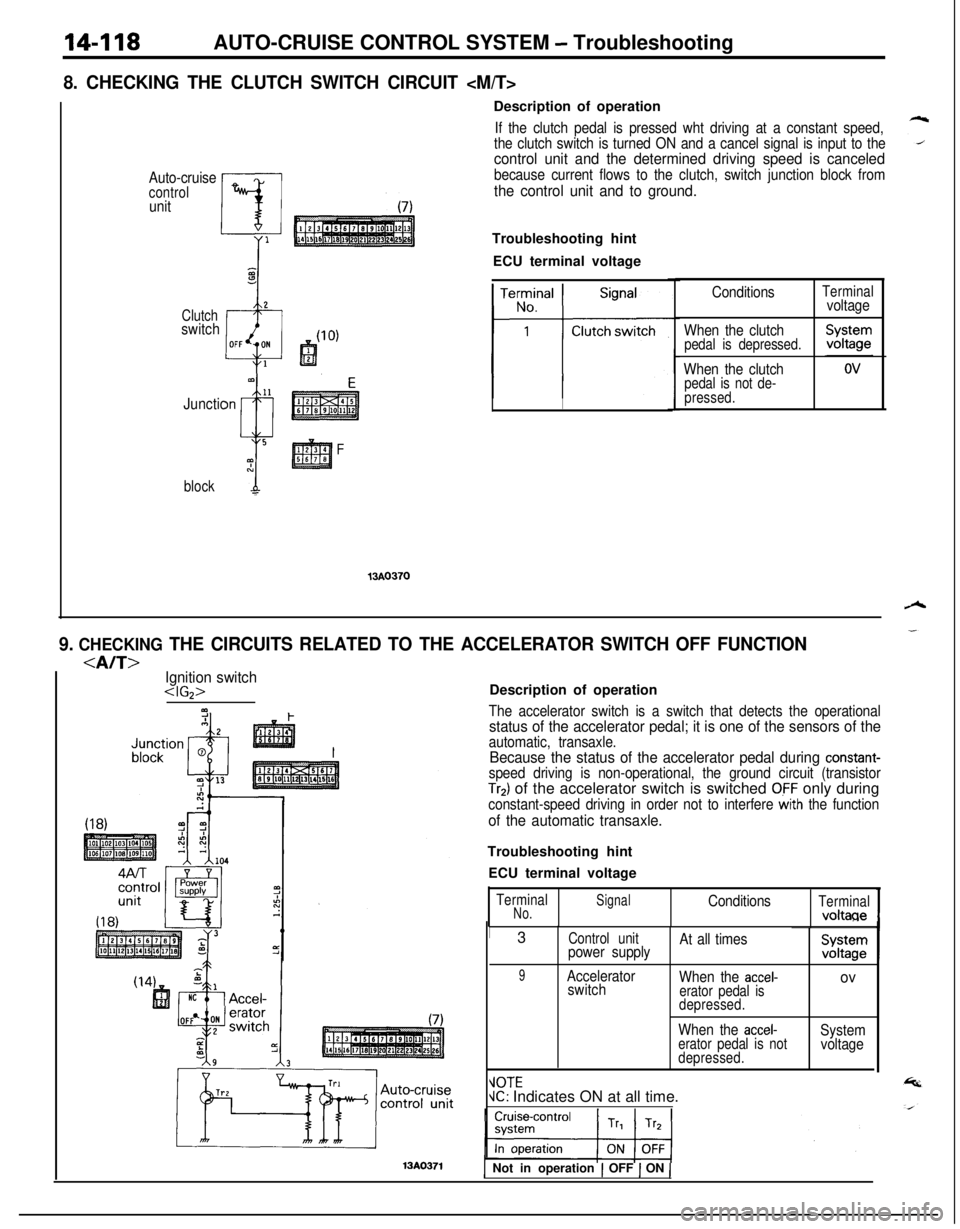
14-118AUTO-CRUISE CONTROL SYSTEM - Troubleshooting
8. CHECKING THE CLUTCH SWITCH CIRCUIT
Auto-cruisecontrolunit9
2ClutchswitchOFF ON
1m11Junction
blockI
13AO370Description of operation
If the clutch pedal is pressed wht driving at a constant speed,
the clutch switch is turned ON and a cancel signal is input to the
control unit and the determined driving speed is canceled
because current flows to the clutch, switch junction block from
the control unit and to ground.Troubleshooting hint
ECU terminal voltage
TerminalSignal
No.
1Clutch switch
t--l--II
ConditionsTerminalvoltage
When the clutch
pedal is depressed.
When the clutchpedal is not de-
pressed.
9. CHECKING THE CIRCUITS RELATED TO THE ACCELERATOR SWITCH OFF FUNCTION
Ignition switch
& Accel-/Description of operation
The accelerator switch is a switch that detects the operationalstatus of the accelerator pedal; it is one of the sensors of theautomatic, transaxle.Because the status of the accelerator pedal during constant-speed driving is non-operational, the ground circuit (transistorTr2) of the accelerator switch is switched OFF only during
constant-speed driving in order not to interfere wtth the function
of the automatic transaxle.Troubleshooting hint
ECU terminal voltage
TerminalNo.SignalConditionsTerminalvoltaoe
’ 3Control unitAt all times
power supply
9Accelerator
When the accel-ovswitcherator pedal is
depressed.
When the accel-Systemerator pedal is not
depressed.voltage
\lOTEJC: Indicates ON at all time.
13AO3711 Not in operation ) OFF 1 ON (
Page 573 of 1216
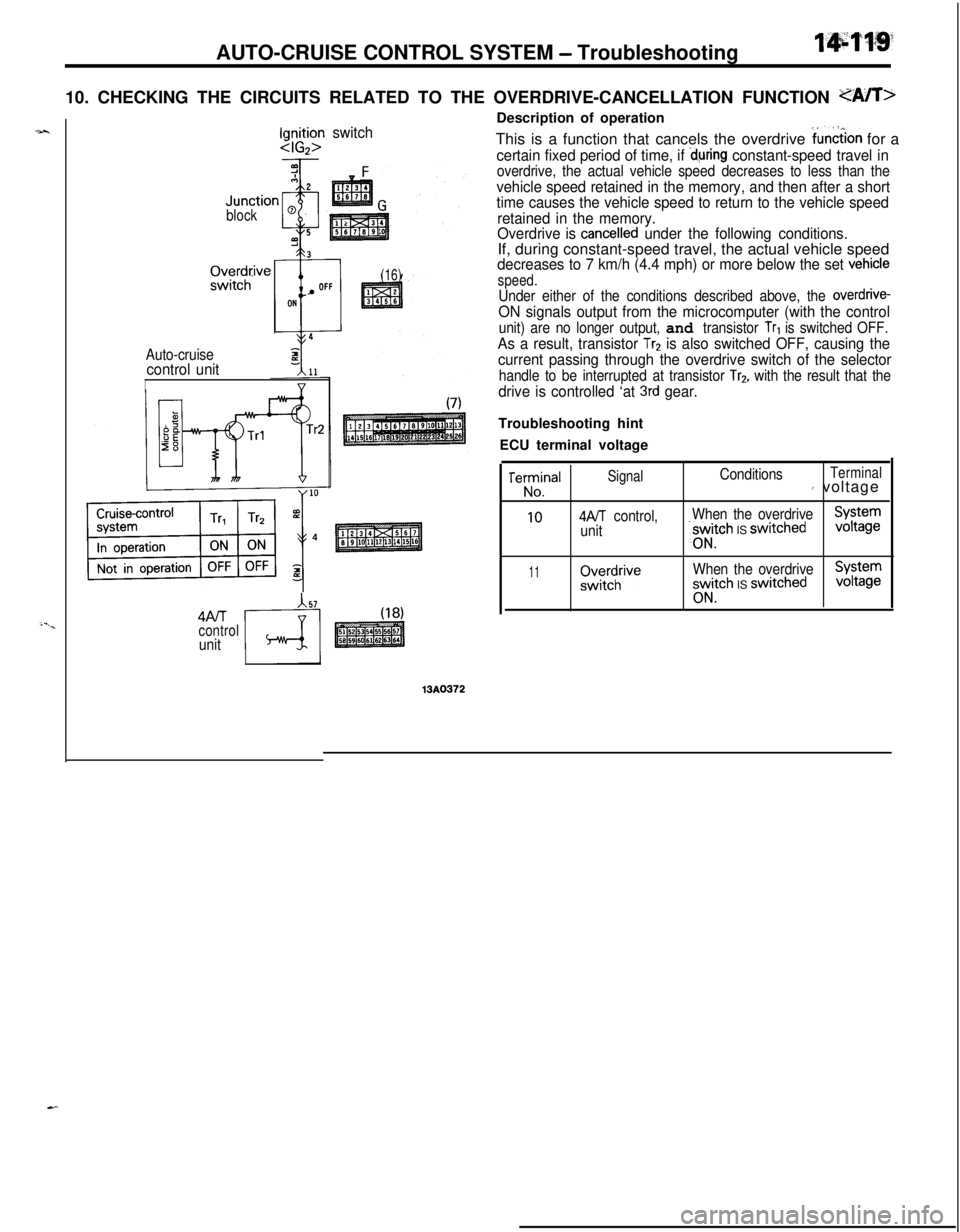
AUTO-CRUISE CONTROL SYSTEM - Troubleshooting1~~ppGJ”10. CHECKING THE CIRCUITS RELATED TO THE OVERDRIVE-CANCELLATION FUNCTION
block
Ov&rive
Auto-cruisecontrol unitswitch
(16)
A574Al-r
control
unitm
(18)Description of operation
This is a function that cancels the overdrive
fur&on for a
certain fixed period of time, if .during constant-speed travel inoverdrive, the actual vehicle speed decreases to less than the
vehicle speed retained in the memory, and then after a short
time causes the vehicle speed to return to the vehicle speed
retained in the memory.
Overdrive is
cancelled under the following conditions.If, during constant-speed travel, the actual vehicle speed
decreases to 7 km/h (4.4 mph) or more below the set vehicle
speed.
Under either of the conditions described above, the overdrive-
ON signals output from the microcomputer (with the control
unit) are no longer output, and transistor Tr, is switched OFF.
As a result, transistor Tr2 is also switched OFF, causing the
current passing through the overdrive switch of the selector
handle to be interrupted at transistor Tr2, with the result that the
drive is controlled ‘at 3rd gear.Troubleshooting hint
ECU terminal voltage
rerNmdra’SignalConditionsTerminali voltage
104A/T control,
unitWhen the overdrive‘sw$ch IS swrtched$ta;;
11;;tt;iveWhen the overdrives&itch IS switched%‘Gg;
Page 574 of 1216
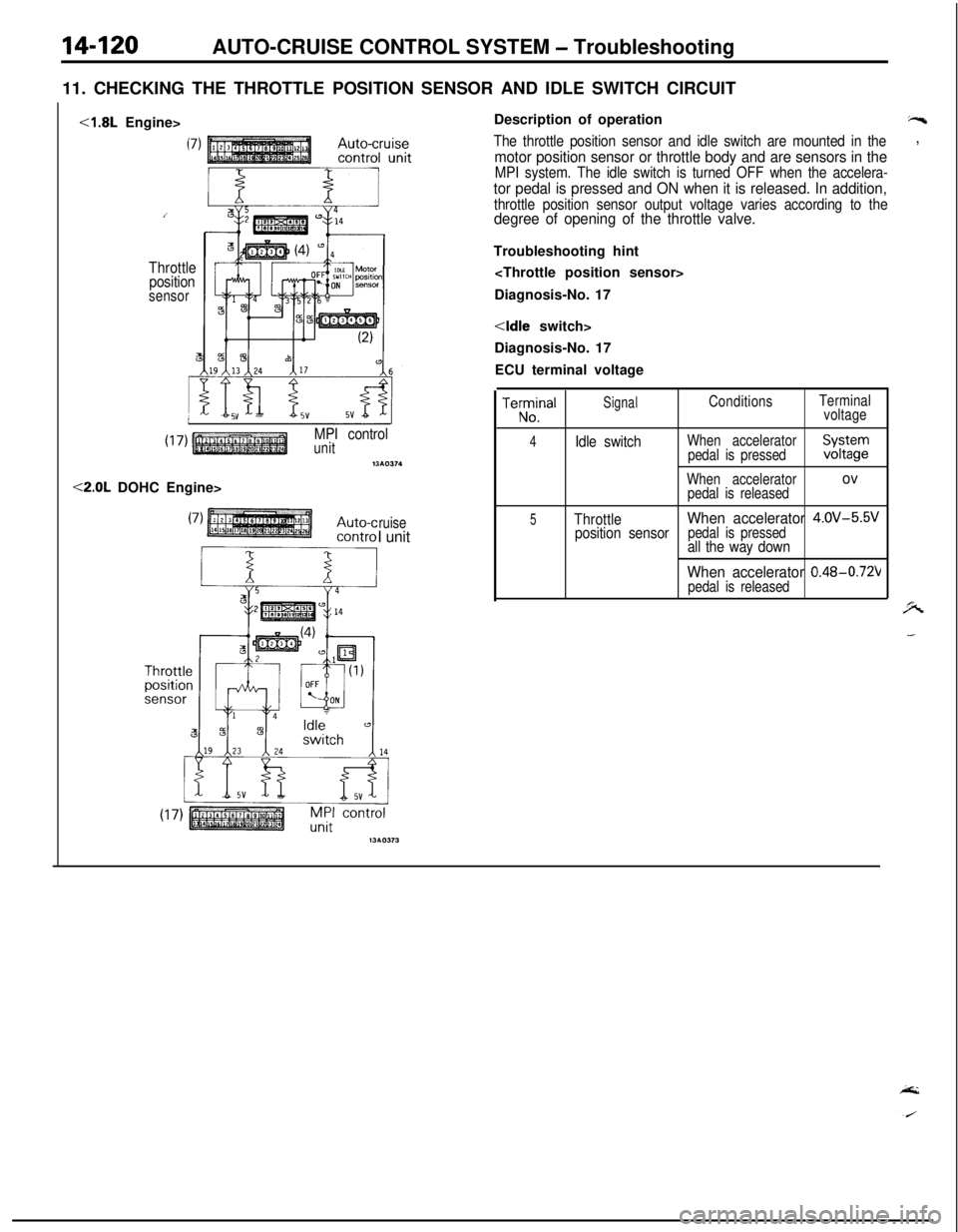
14-120AUTO-CRUISE CONTROL SYSTEM - Troubleshooting
11. CHECKING THE THROTTLE POSITION SENSOR AND IDLE SWITCH CIRCUIT<1.8L Engine>
Throttle
position
sensor
MPI controlunitnw374<2.0L DOHC Engine>
ruiseI unitDescription of operation
“s
The throttle position sensor and idle switch are mounted in the,
motor position sensor or throttle body and are sensors in theMPI system. The idle switch is turned OFF when the accelera-
tor pedal is pressed and ON when it is released. In addition,
throttle position sensor output voltage varies according to thedegree of opening of the throttle valve.Troubleshooting hint
Diagnosis-No. 17
Diagnosis-No. 17
ECU terminal voltageTeKlna’
SignalConditionsTerminal
voltage
4Idle switchWhen accelerator
pedal is pressedXFgr
When acceleratorovpedal is released
5ThrottleWhen accelerator 4.OV-5.5V
position sensorpedal is pressedall the way down
When accelerator 0.48-0.72Vpedal is released
Page 575 of 1216

AUTO-CRUISE CONTROL SYSTEM - Troubleshooting'14421
16A065i
Auto-cruise
16LOOS
SELF-DIAGNOSIS CHECKSelf-diagnosis checking is performed when there has been an
automatic cancellation, without cancel switch
operati’on.(1) The following method can be used for checking the
diagnosis. Note that the diagnosis check connector is
located under the driver’s side instrument panel.
Connect a voltmeter between the ground terminal and the
terminal for auto-cruise control of the diagnosis check
connector.It is possible to discover which circuit is the cause of the
cancellation by verifying the indication shown by the
voltmeter with the display patterns shown on the next
page.(2) When the diagnosis code No. is displayed, inspect accord-
ing to the inspection chart No. related to each code No.
NOTECanceling the diagnosis codes
The diagnosis codes remain in memory until the battery is
turned off but they can be canceled in the following ways
without disconnecting the battery terminals.
1. By turning on the ignition switch
2.By turning the cruise switch ON while the SET switch is ONand then, within 1 second, turning the RESUME switch
ON. (Put into condition for input check reception)
3.By turning ON set SET switch and stop light switch at the
same time and continuing the ON condition for 5 seconds
or more.
4.By checking that the diagnosis codes are canceled using avoltmeter.
Page 576 of 1216
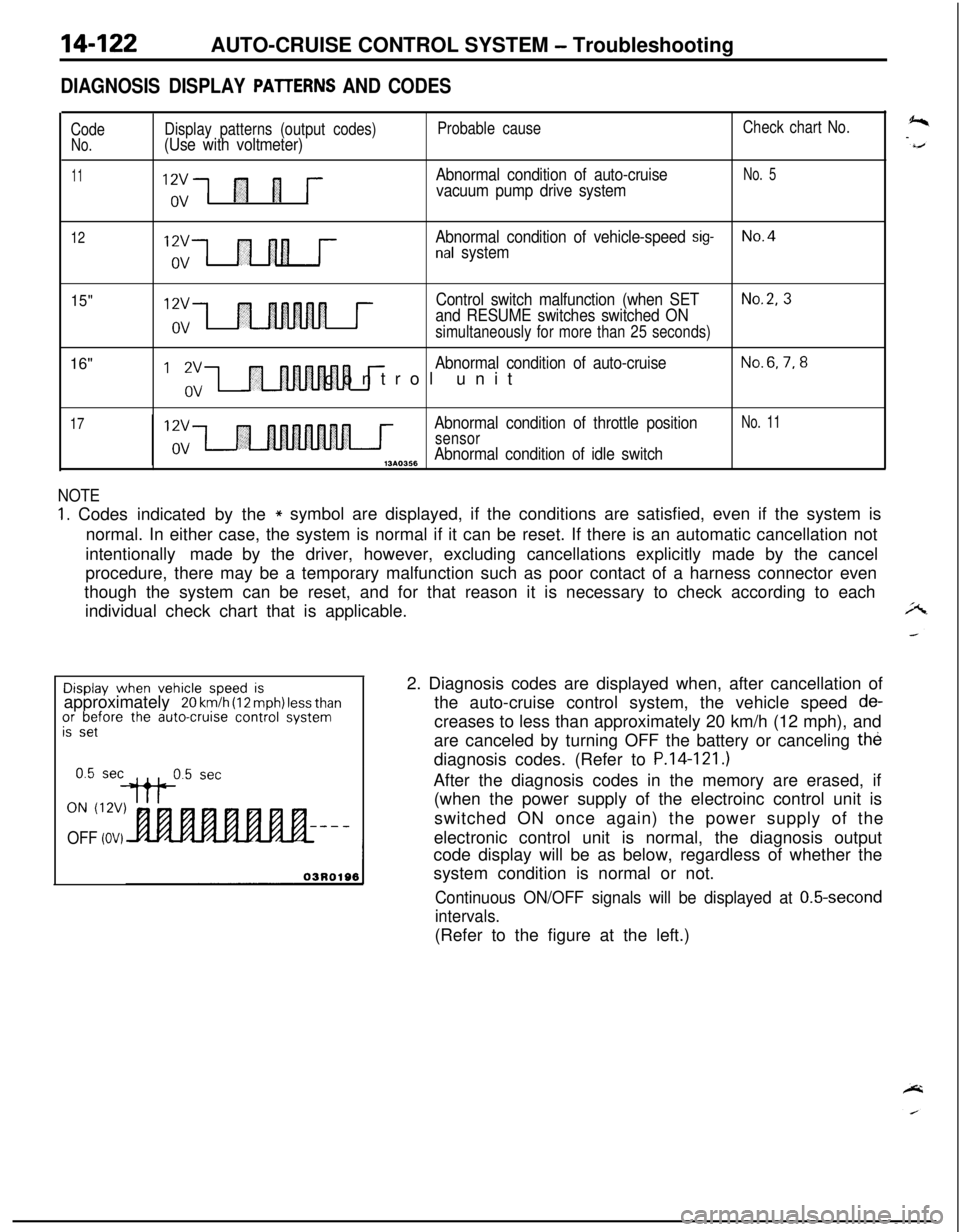
14-122AUTO-CRUISE CONTROL SYSTEM - Troubleshooting
DIAGNOSIS DISPLAY PAlTERNS AND CODES
CodeNo.
11
Display patterns (output codes)(Use with voltmeter)
“,;1 fl 1 j--
Probable cause
Abnormal condition of auto-cruise
vacuum pump drive system
Check chart No.
No. 5
12Abnormal condition of vehicle-speed sig-No.4nal system
15"16"12vControl switch malfunction (when SETNo.2, 3
and RESUME switches switched ONovsimultaneously for more than 25 seconds)
I ‘,“,-I r
Abnormal condition of auto-cruiseNo.6,7,8control unit
17Abnormal condition of throttle positionNo. 11
sensorAbnormal condition of idle switch,3*0356
NOTE
1. Codes indicated by the* symbol are displayed, if the conditions are satisfied, even if the system is
normal. In either case, the system is normal if it can be reset. If there is an automatic cancellation not
intentionally made by the driver, however, excluding cancellations explicitly made by the cancel
procedure, there may be a temporary malfunction such as poor contact of a harness connector even
though the system can be reset, and for that reason it is necessary to check according to each
individual check chart that is applicable.Display
when vehicle speed isapproximately 20 km/h (12 mph) less thanor before the auto-cruise control systemis set
ON (12V)
OFF (OV)2. Diagnosis codes are displayed when, after cancellation of
the auto-cruise control system, the vehicle speed
de-creases to less than approximately 20 km/h (12 mph), and
are canceled by turning OFF the battery or canceling the
diagnosis codes. (Refer to
P.14-121.)After the diagnosis codes in the memory are erased, if
(when the power supply of the electroinc control unit is
switched ON once again) the power supply of the
electronic control unit is normal, the diagnosis output
code display will be as below, regardless of whether the
system condition is normal or not.
Continuous ON/OFF signals will be displayed at 0.5-second
intervals.(Refer to the figure at the left.)
Page 577 of 1216
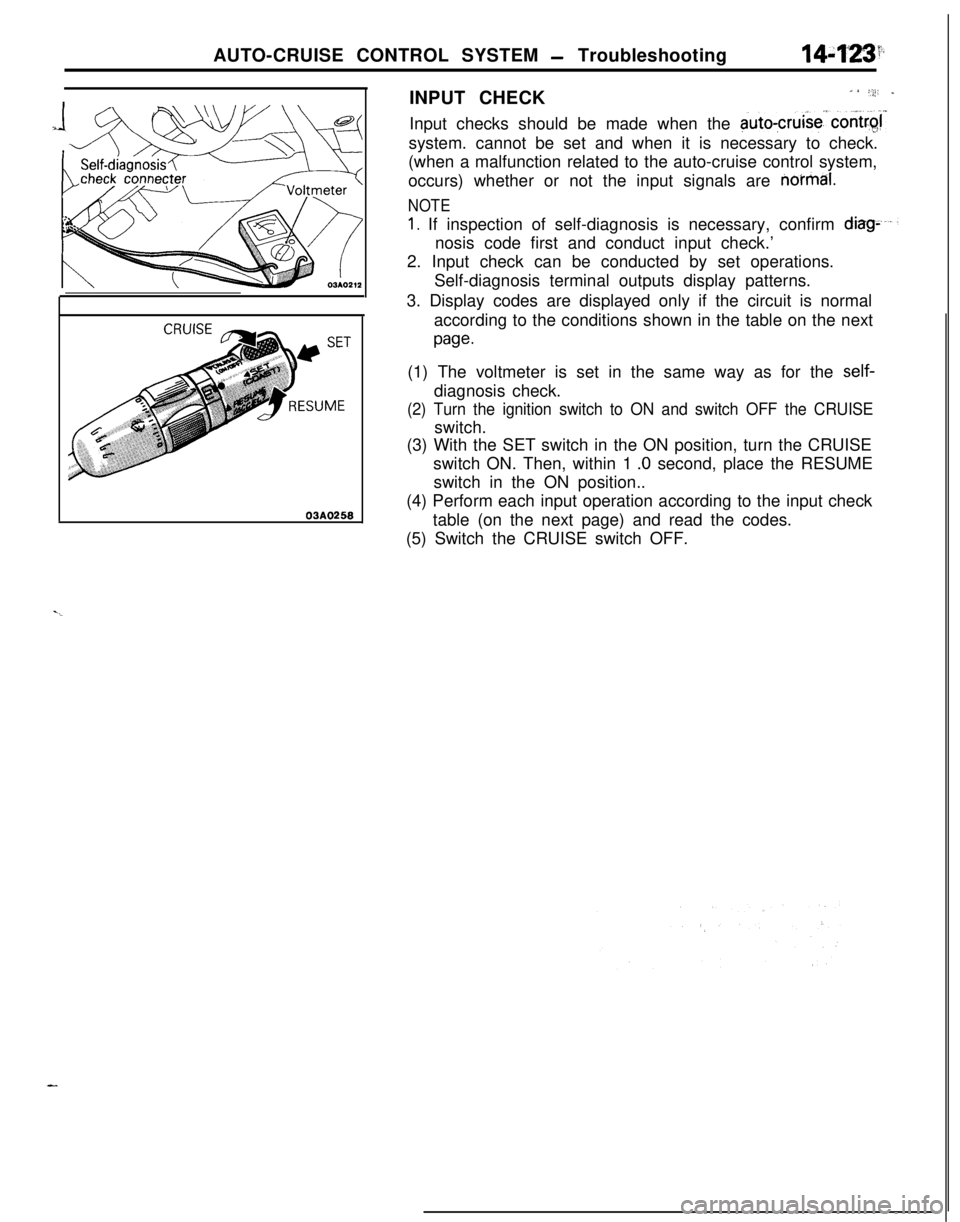
AUTO-CRUISE CONTROL SYSTEM - Troubleshooting14:f*L3’.INPUT CHECK
a *:;i’ _Input checks should be made when the
auto-cruise’.contr$system. cannot be set and when it is necessary to check.
(when a malfunction related to the auto-cruise control system,
occurs) whether or not the input signals are
no’rmal.
03A0258
NOTE
1. If inspection of self-diagnosis is necessary, confirm diag-nosis code first and conduct input check.’
2. Input check can be conducted by set operations.
Self-diagnosis terminal outputs display patterns.
3. Display codes are displayed only if the circuit is normal
according to the conditions shown in the table on the next
page.(1) The voltmeter is set in the same way as for the
self-diagnosis check.
(2) Turn the ignition switch to ON and switch OFF the CRUISEswitch.
(3) With the SET switch in the ON position, turn the CRUISE
switch ON. Then, within 1
.O second, place the RESUME
switch in the ON position..
(4) Perform each input operation according to the input check
table (on the next page) and read the codes.
(5) Switch the CRUISE switch OFF.
Page 578 of 1216
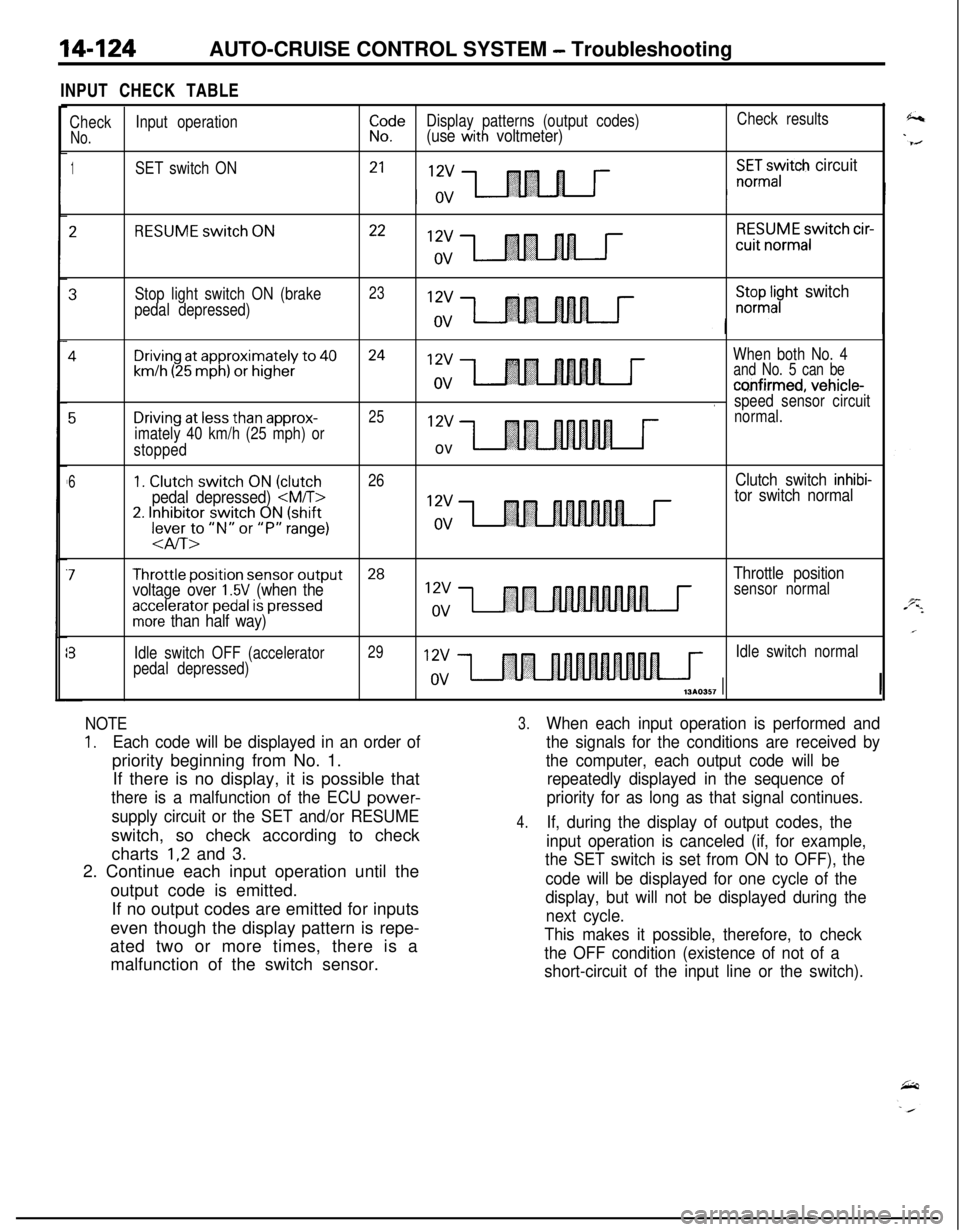
14-124AUTO-CRUISE CONTROL SYSTEM - Troubleshooting
INPUT CHECK TABLE
CheckInput operationiI!eDisplay patterns (output codes)Check results
No.(use with voltmeter)
1SET switch ON21X:Gayitch circuit
2RESUME switch ON2212vRESUME switch cir-cuit
normalov
3Stop light switch ON (brake23
pedal depressed)
;;pl;yht switch
4Driving at approximately to 4024When both No. 4
km/h (25 mph) or higherand No. 5 can be
co,nfirmed, vehicle-.speed sensor circuit
5Driving at less than approx-2512vnormal.
imately 40 km/h (25 mph) or
stopped
ov
61. Clutch switch ON (clutch26Clutch switch inhibi-
pedal depressed)
2. Inhibitor switch ON (shift12vlever to “N” or “P” range)ov
-aIT>
7Throttle position sensor output28
voltage over 1.5V (when theThrottle positionsensor normal
accelerator pedal is pressedmore than half way)
?Idle switch OFF (accelerator29Idle switch normal
pedal depressed)
NOTE
1.Each code will be displayed in an order ofpriority beginning from No. 1.
If there is no display, it is possible that
there is a malfunction of the ECU power-
supply circuit or the SET and/or RESUMEswitch, so check according to check
charts
1,2 and 3.
2. Continue each input operation until the
output code is emitted.
If no output codes are emitted for inputs
even though the display pattern is repe-
ated two or more times, there is a
malfunction of the switch sensor.
3.When each input operation is performed and
the signals for the conditions are received by
the computer, each output code will be
repeatedly displayed in the sequence of
priority for as long as that signal continues.
4.If, during the display of output codes, the
input operation is canceled (if, for example,
the SET switch is set from ON to OFF), the
code will be displayed for one cycle of the
display, but will not be displayed during the
next cycle.
This makes it possible, therefore, to check
the OFF condition (existence of not of a
short-circuit of the input line or the switch).
Page 579 of 1216
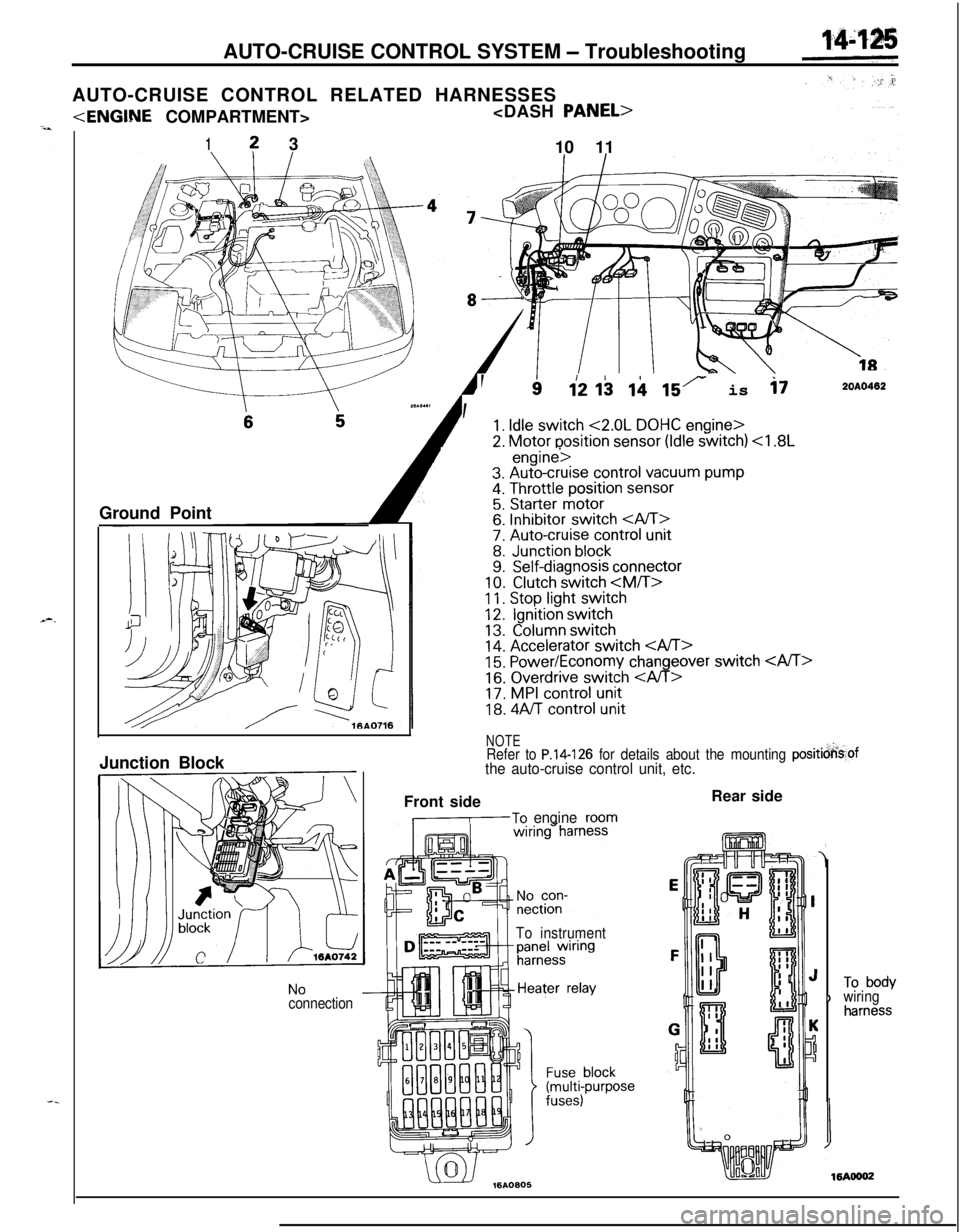
AUTO-CRUISE CONTROL SYSTEM - Troubleshooting
AUTO-CRUISE CONTROL RELATED HARNESSES
1? 3
10 11
Ground Point
--
, ’
112 I$ ii 15r is i72OAO402
1. Idle switch <2.0L DOHC engine>
2. Motor position sensor (Idle switch)
11. Stop light switch12.Ignition switch
13.Column switch14. Accelerator switch 15. Power/Economy changeover switch
16. Overdrive switch
18. 4Aff control unit
NOTERefer to P.14-126 for details about the mounting positicjkof
the auto-cruise control unit, etc.Junction Block
NoconnectionFront side
,-To engineroom
To instrumentRear side
)To bodywiringharness
Page 580 of 1216
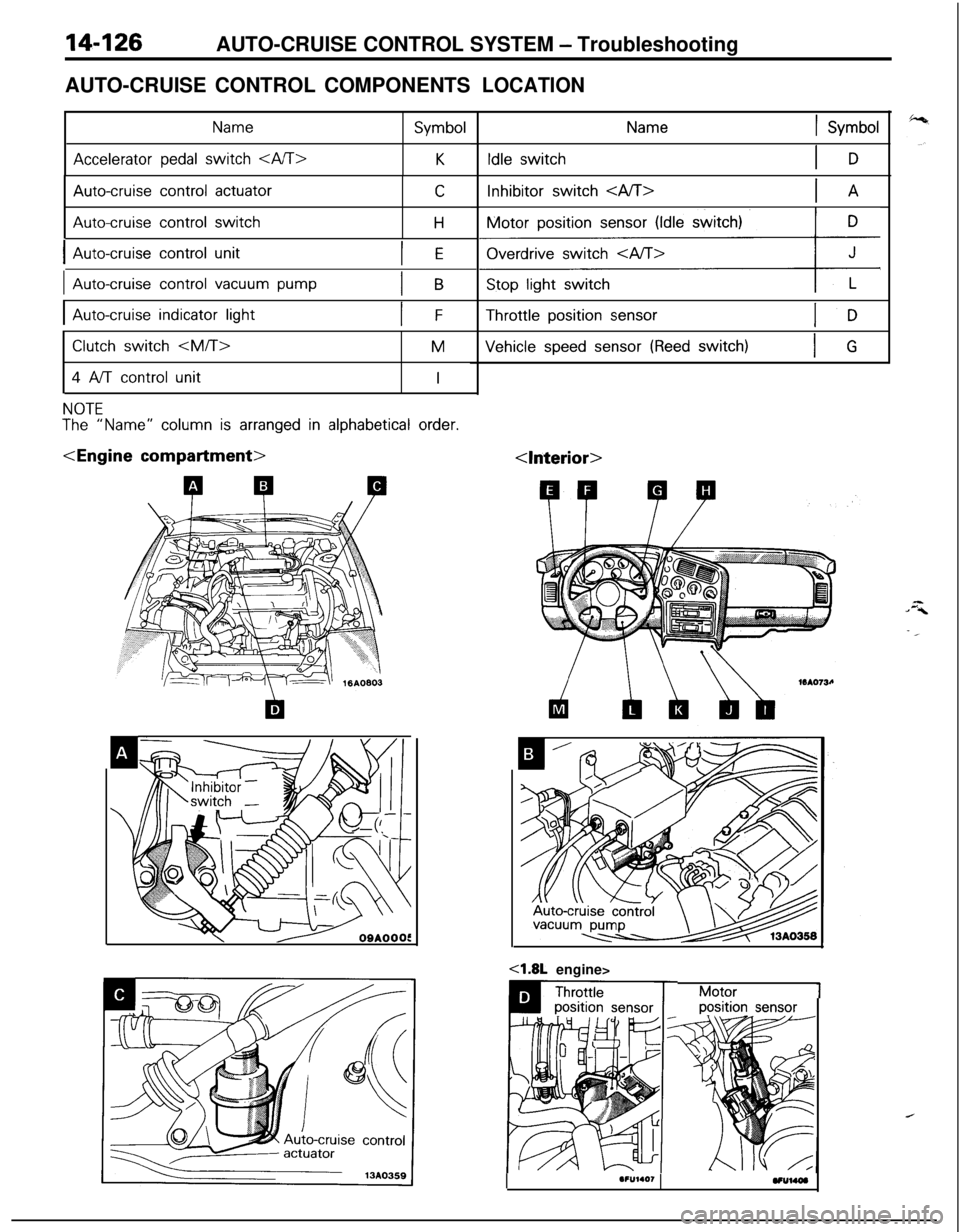
14-126AUTO-CRUISE CONTROL SYSTEM - Troubleshooting
AUTO-CRUISE CONTROL COMPONENTS
Name
Accelerator pedal switch
Symbol
K
Auto-cruise control actuator
Auto-cruise control switch
C
H
IAuto-cruise control unitIE
IAuto-cruise control vacuum pumpIB
IAuto-cruise indicator lightIF
Clutch switch
4 A/T control unit
M
I
NOTE
The “Name” column is arranged in alphabetical order.
LOCATION
1 Symbol
Idle switchIDInhibitor switch
Motor position
sensor (Idle switch)
ziz&Gy+Throttle position
sensor
Vehicle speed sensor (Reed switch)IG
Motor1position sensor
I.F”l.O,VUUW